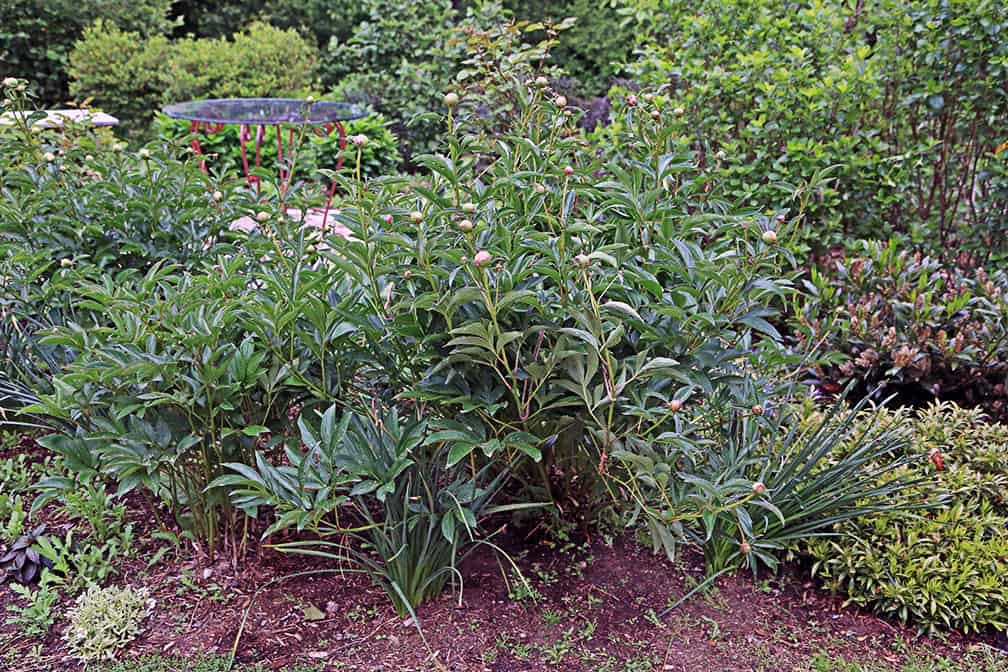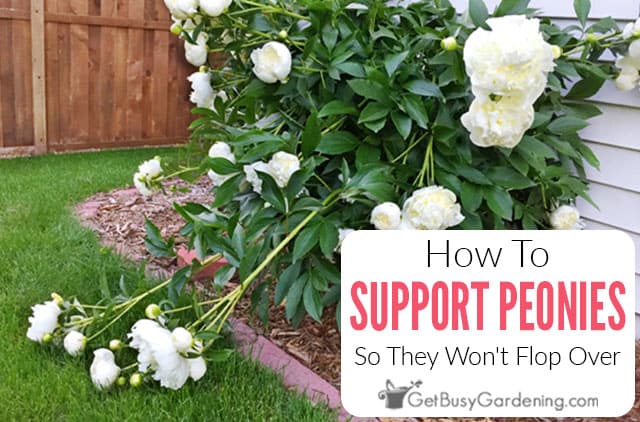To stake peonies, use bamboo stakes and garden twine for support, tying the stems loosely as the plant grows. Peonies are charming and vibrant flowers that bring beauty and elegance to any garden.
However, their heavy blooms can cause the stems to bend or break, especially during periods of rain or wind. Therefore, it is essential to stake peonies to provide them with the necessary support. By using bamboo stakes and garden twine, you can ensure that the stems remain upright and strong.
In this guide, we will explore the simple steps you can take to stake peonies effectively. With proper staking, you can enjoy these stunning flowers in all their glory without worrying about their structural integrity.

Credit: gardenlady.com
The Importance Of Staking Peonies
Staking peonies is crucial to ensure their healthy growth and stunning beauty. Proper staking provides several benefits that contribute to the overall well-being of these delicate flowers.
Reasons for staking peonies:
- Support: Stakes help keep the heavy peony blooms upright, preventing them from drooping or leaning towards the ground.
- Protection: By providing support, staking minimizes the risk of damage caused by wind, rain, or heavy storms.
- Aesthetics: Well-staked peonies create an enchanting visual appeal, showcasing the full brilliance of their blossoms.
- Optimal Air Circulation: Proper staking allows sufficient air circulation around the plant, reducing the risk of fungal diseases.
- Easier Maintenance: Staked peonies are easier to care for, as they are not prone to tangling or crowding other nearby plants.
Benefits of properly staked peonies:
- Longer Blooming Period: Staking supports the heavy flower heads, extending their vibrant display.
- Enhanced Flower Quality: Properly staked peonies produce fuller and more symmetrical blooms.
- Improved Pollination: Upright flowers attract pollinators more effectively.
Different staking techniques to consider:
| Techniques | Description |
|---|---|
| Single Stake | A single stake is inserted near the center of the peony plant to provide support for the entire plant. |
| Cage | A wire or bamboo cage is placed around the peony to support the entire plant, allowing its stems to grow through the gaps. |
| Grid | A grid of stakes and twine is formed around the plant, creating a supportive structure. |
| Ring | A metal or plastic ring is placed around the peony to keep its stems and blooms upright. |
When To Stake Peonies
Staking peonies at the right time is crucial for their growth and support. Timing plays a significant role in achieving optimal results. Peonies should be staked before they start to droop or lean excessively. Identifying the right stage for staking is essential to avoid damaging the plants or hindering their growth. Generally, it is recommended to stake peonies when they are around 12 to 18 inches tall.
Factors to consider before staking include the plant’s overall health, the size and weight of blooms, and the weather conditions. Staking should be done gently, with the support provided at the plant base and tied securely using soft ties. Stakes should be tall enough to support the plant without causing any damage to the roots. By staking peonies at the appropriate time, gardeners can ensure their stunning blooms are displayed to their full potential.
How to Stake Peonies: Step by Step Guide
Supplies Needed For Staking Peonies
For staking peonies, you will need a few supplies to provide them with proper support. The essential staking materials include sturdy stakes, soft ties or twine, and garden tape or clips. These materials will help keep the peony plants upright and prevent them from falling over.
If you prefer additional support, there are optional accessories available. Peony cages can offer extra stability, especially for larger blooms. They are designed to encircle the entire peony plant, providing support from all angles. Another option is to use decorative supports that not only offer functionality but also add visual appeal to your garden.
By using the right staking materials, you can ensure that your peonies grow tall and straight, allowing their beautiful blooms to shine. Proper staking will also help protect the delicate stems from breaking and prevent damage from strong winds or heavy rain.
Stake Peonies Correctly
When it comes to staking peonies correctly, there are a few key steps you should follow to ensure your plants have the support they need to thrive. Start by preparing the area around your peonies, clearing away any debris and ensuring there is adequate spacing between plants. Next, position stakes strategically near the base of the peonies, taking care not to damage the roots. There are different staking techniques to choose from, depending on whether you have single or multiple stems. For single stems, use individual stakes to support each one. For multiple stems, the loop and cradle technique can be effective.
To secure the peonies to the stakes, use soft ties or twine, being careful not to damage the stems. As the peonies grow, adjust the ties to accommodate their increasing height. If additional support is needed, consider installing peony cages or utilizing decorative supports that blend well with your garden aesthetic.
Tips And Tricks For Successful Peony Staking
Staking peonies is essential for their successful growth and blooming. Choosing the right stake height is an important factor to consider. The stake should be tall enough to support the heavy blooms without bending or breaking. A general rule of thumb is to use stakes that are approximately two-thirds the height of the mature peony plant.
When it comes to considering weather conditions, it is crucial to secure the stakes firmly in the ground to withstand strong winds or heavy rains. Using sturdy materials such as bamboo or metal stakes is recommended for better durability.
Maintaining staked peonies throughout the season involves regularly checking the ties and adjusting them as the plant grows. It is important to use soft ties like garden twine or strips of fabric to prevent damaging the stems. Moreover, periodically removing any dead or damaged foliage or blooms will help maintain the plant’s overall health.
Troubleshooting Common Peony Staking Issues
One common issue when staking peonies is dealing with bent or floppy stems. To prevent this, make sure to use sturdy stakes and tie the stems loosely with soft twine. Supporting the stems as they grow taller can also help.
Stems breaking under the weight of blooms can be another problem in peony staking. To avoid this, consider providing additional support by using larger and stronger stakes. Attaching stakes closer to the base of the plant can also help distribute the weight evenly.
Wind damage to staked peonies can be a concern, especially in areas with strong gusts. Adding additional stakes around the main stake or tying the plant to a nearby fence or trellis can provide extra support against wind damage.
Addressing pests and diseases is crucial in maintaining healthy peonies. Regularly inspect the plants for insects or diseases, and take appropriate measures to address any issues. Providing proper ventilation and avoiding overcrowding can also help prevent diseases.
Frequently Asked Questions For How To Stake Peonies
How Deep Should I Plant Peonies?
Peonies should be planted at a depth of 2-3 inches below the soil surface. This ensures that the roots are well insulated and protected, allowing the plant to thrive. Planting them too deep can lead to poor blooming, while planting them too shallow can expose the roots to cold temperatures.
When Is The Best Time To Stake Peonies?
It’s best to stake peonies in early spring, before the plant begins to grow tall. This allows you to position the stakes without disturbing the plant’s delicate shoots. Staking early also helps support the heavy blooms and prevents them from flopping over once they appear.
What Materials Can I Use To Stake Peonies?
There are several materials you can use to stake peonies, including bamboo stakes, metal stakes, or even customized peony rings. Bamboo stakes are affordable and can be easily cut to the desired length. Metal stakes are durable and provide strong support.
Peony rings are designed specifically for peonies and provide excellent support without damaging the stems.
How Do I Stake Peonies Without Damaging The Stems?
To stake peonies without damaging the stems, use soft materials such as twine, stretchy plant ties, or strips of fabric. Avoid using wires or materials that can cut into the stems. Wrap the material loosely around the stems, making sure to leave room for growth.
Secure the material to the stakes, gently supporting the plant without constricting its growth.
Conclusion
You’ve now mastered the art of staking peonies! Following these simple steps, you can ensure your peonies grow beautifully and stand tall. From choosing the right staking materials to providing gentle support, your peonies will flourish in your garden. Remember to check the stakes regularly and adjust them as needed.
With a little care and attention, your peonies will reward you with stunning blooms year after year. Happy gardening!

